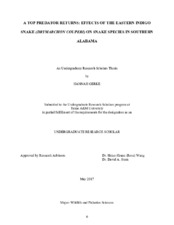| dc.description.abstract | Increasing focus has been placed on snakes and their role in the ecosystem. As a key predator in longleaf pine ecosystems, the eastern indigo snake (Drymarchon couperi) feeds on a variety of taxa, but recent studies have shown an innate preference for snakes and pit vipers in particular. Once found throughout the southeastern United States, its decreasing range and numbers resulted in its extirpation from many areas. In 2008, reintroduction efforts for the eastern indigo were initiated in the Conecuh National Forest (CNF) in southern Alabama. Six years after its reintroduction, drift fences were constructed to survey the herpetofauna in control sites as well as sites where the eastern indigo snake was released. The objective of this study was to assess the effects of the eastern indigo snake on snake species in Southern Alabama. Field data were collected from reintroduction and non-reintroduction sites within CNF to test the hypotheses that at reintroduction sites, 1) the capture rates of venomous snakes decreased, 2) the capture rates of the most common species were reduced, and 3) the average sizes of snakes were larger. The three most commonly detected snake species were southern black racers (Coluber constrictor priapus), eastern copperheads (Agkistrodon contortrix), and eastern coachwhips (Coluber flagellum flagellum). There were significantly less black racers in the reintroduction sites than the control sites, suggesting the black racer’s high numbers and active lifestyle may result in higher predation by the indigo snakes. Surprisingly, the size (total length and mass) of male racers and copperheads and the mass of female coachwhips were significantly smaller in the reintroduction sites. We suggest an relationship between body size and home ranges or daily movements that results in increased predation by indigo snakes. However, difficulties in study design and sample size must be taken into account when interpreting results, and more research is needed to establish direct causal links. | en |


